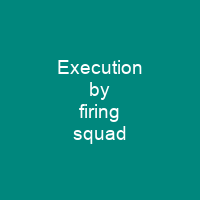Execution by Firing Squad: A Dark Chapter in History
Imagine a scene where the sound of gunfire echoes through the air, marking the end of someone’s life. This is what execution by firing squad entails—a method of capital punishment that has been used throughout history for various crimes and during wartime.
The Mechanics of Execution by Firing Squad
Execution by firing squad involves a group of soldiers who fire simultaneously at the condemned person, aiming to kill them quickly. This method was often chosen due to its efficiency in ending lives swiftly and minimizing disfigurement. The prisoner is typically blindfolded or hooded and restrained, with executions sometimes carried out early in the morning.
Historical Context: From War to Peace
How did this method of execution come about? And why was it used so frequently during wartime?
The use of firing squads dates back to ancient times but gained prominence during wars and military conflicts. In peacetime, countries like Brazil have abolished the death penalty for most crimes, while others continue to use it under specific circumstances. For instance, in Chile, hundreds were executed by firing squad after a 1973 military coup.
Notable Cases: From World War I to Modern Times
Think of the famous cases where execution by firing squad played a significant role:
- Thomas Highgate and Pte. Harry Farr were among the first British soldiers executed for desertion during World War I.
- Mata Hari, the legendary spy, was executed in 1917 by a French firing squad.
- In Indonesia, drug offenders like Myuran Sukumaran and Andrew Chan faced execution by firing squad in 2015.
Execution Methods Around the World
How does this method compare to others used around the world?
While some countries have abolished capital punishment, others continue to use it. In Saudi Arabia, beheading is a common form of execution, while in the United Arab Emirates, firing squads are preferred. The United Kingdom outlawed hanging as a method of execution in 1965, and the last execution by firing squad took place in Utah in 2010.
Modern Controversies: Reluctance and Resurgence
Why is there renewed interest in this method?
The reluctance of pharmaceutical companies to supply lethal injection drugs has led to a resurgence of interest in firing squads. Several states, including South Carolina, Idaho, Mississippi, Oklahoma, and Utah, have considered or are using it as an alternative.
Conclusion: A Dark Chapter in History
The use of execution by firing squad is a dark chapter in history, marked by its efficiency and the pain it inflicts. While some countries continue to use this method, others have moved away from it, recognizing the human rights implications.

You want to know more about Execution by firing squad?
This page is based on the article Execution by firing squad published in Wikipedia (retrieved on March 7, 2025) and was automatically summarized using artificial intelligence.







